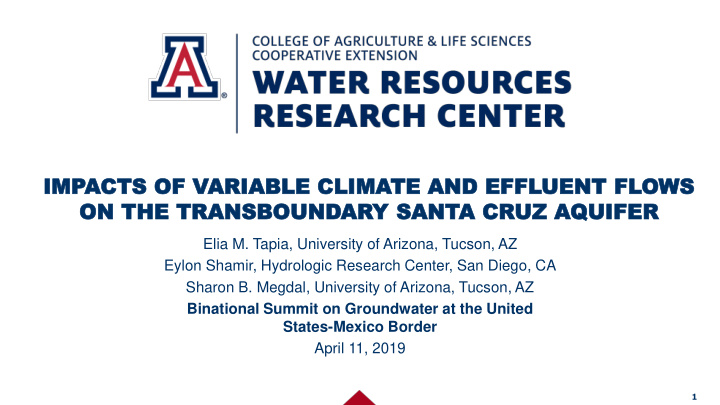



IMP IMPACTS CTS OF OF VARIAB ARIABLE LE CLIMA CLIMATE TE AND AND EFF EFFLUENT UENT FL FLOWS WS ON THE ON THE TRA TRANSBOUND NSBOUNDAR ARY Y SANT SANTA A CR CRUZ UZ AQUIFER QUIFER Elia M. Tapia, University of Arizona, Tucson, AZ Eylon Shamir, Hydrologic Research Center, San Diego, CA Sharon B. Megdal, University of Arizona, Tucson, AZ Binational Summit on Groundwater at the United States-Mexico Border April 11, 2019 1
The T he TAA AAP P and t and the T he Transbound ansboundar ary y Sant Santa Cr a Cruz uz Aquif Aquifer er Firma del Acuerdo del TAAP por parte de los Ingenieros Principales de EUA y Méx. Agosto, 2009 Signing of TAAP Agreement by US and Mexican Principal Engineers – August 2009 2
The T he Transbound ansboundar ary S y Santa Cr anta Cruz uz Aquif Aquifer er Ambos Ambos Nogales Nogales 3
Institutiona Institutional l Bac Backg kground ( ound (U.S.) .S.) • Decentralized U.S. water governance • Arizona follows the 1980 Groundwater Management Act • Active Management Areas • Assured Water Supply (AWS) rules: “safe - yield” • Current AWS rules for the Santa Cruz AMA are in draft form • Process for new/updated AWS rules (ADWR, 1999) 4
Instit Institution utional Bac al Backg kground ound (Me (Mexico) xico) • Mexico: centralized water governance • CONAGUA was created in 1989 to “manage and preserve Mexico’s water resources” • Mexico’s National Water Law (1992) • Article 27 of the Mexican Constitution: “Ownership of the lands and waters within the boundaries of the national territory is vested originally in the Nation, which has had, and has, the right to transfer title thereof to private persons, thereby constituting private property” • Chapter 16 of the National Water Law (reformed in 2004): sewage produced after using the national waters is also the property of the nation 5
Bina Binationa tional Bac Backg kground ound (IBW (IBWC/ C/CILA CILA) • Minute 206 (1958): Joint operation and maintenance of the Nogales International NIWTP Actual capacity: Sanitation Project. 645 lps (28,259 MGD) • Minute 227 (1967): Enlargement of the MX: 434 lps (19,015 MGD) international facilities for the treatment of AZ: 211 lps (9,244 MGD) Nogales, AZ, and Nogales, Son. sewage. • Minute 276 (1988): Conveyance, treatment and Los Alisos Wastewater Treatment Plant (LAWTP) disposal of sewage from Nogales, AZ and Nogales, Son. exceeding the capacities allotted to the US and MX at the Nogales International sewage treatment plan. • Minute 294 (1994): Facilities planning program for the solution of border sanitation problems. Actual capacity: 220 lps (9,639 MGD) Future enlargement: 330 lps (14,458 MGD) 6
Uncertaint Uncer tainties ies in the Ar in the Area ea of of Focus ocus • Climate • Precipitation changes • Temperature changes • Groundwater Extraction • Primary source of water • Changes in effluent discharges • The perennial reach is fed by discharges from the Nogales International Wastewater Treatment Plant (NIWTP) 7
Analysis Anal ysis do downstr wnstream of eam of the NIWTP the NIWTP • Water Budget Model approach that allows to test the water balance for many likely scenarios and for long durations. • Tested scenarios: • Changes of natural flow as a result of projected climate change. • Changes in available effluent from the NIWTP. • Changes in consumption demand. 8
Inflo Inflows and Outfl ws and Outflows ws Sources of Information: • Shamir et al., 2007; Shamir et al., 2014; Shamir et al., 2017a • Nelson (2007) [ADWR Modelling Report #14] • ADWR (2012) [Demand and Supply Assessment 1985-2025 Santa Cruz Active Management Area] • IBWC registries 9
NIWTP Ef NIWTP Effluent D fluent Disc ischar harge ge Effluent discharge scenarios No. Scenarios Mm3/ yr 1 Average pre-LAWTP 17.44 2 Maximum pre-LAWTP 24.60 3 Minimum pre-LAWTP 12.58 4 Average post-LAWTP 16.02 5 Maximum post-LAWTP 22.08 6 Minimum post-LAWTP 14.60 7 Agreed upon contributions 20.34 Arizona's average contributions 8 (1996-2018) 5.42 10
Modeling R Modeling Results esults 12 out of 40 years ended with a positive water balance Annual Annual water balance c ter balance calcula alculated ted for 1978 or 1978-2017 2017 with the pre-LA with the pr LAWTP WTP disc dischar harge ge scenarios scenarios 11
Cumula Cumulativ tive e water ter budget f budget for or 1978 1978-2017 with 2017 with dif differ erent ent trea tr eated ted ef effluent fluent disc dischar harge ge scenarios scenarios fr from om the the NI NIWTP WTP 12
Cumulative distributions of projected 2020-2059 40-year cumulative water balance by three GCMs • Projections show variations that range from severe long-term drying to positive wetting. 13
Dis Discuss cussion ion • This study demonstrates the use of a conceptual water budget model as a tool for assessing the long- term impact of effluent discharge, climate uncertainties, and groundwater pumping in a portion of the TSCA • Need for local agreements and regulations to achieve the SCAMA management goals • Gaps in transboundary water governance. • Effluent discharge downstream of the NIWTP represents more than 20% of the average annual mass balance for the study area. • Minutes 227 and 276: Mexico reserves the right to reclaim the effluent from the NIWTP that is equivalent to the sewage inflow from Nogales, Sonora. • Minutes do not specify the mechanisms by which Mexico can use or reclaim their treated effluent. • A new agreement should consider the TSCA as an interrelated binational system that reflects groundwater and wastewater treatment demands of each nation, and the environmental water needs for the area. 14
Thank y hank you! ou! Elia M. Tapia emtapia@email.arizona.edu 15
Recommend
More recommend